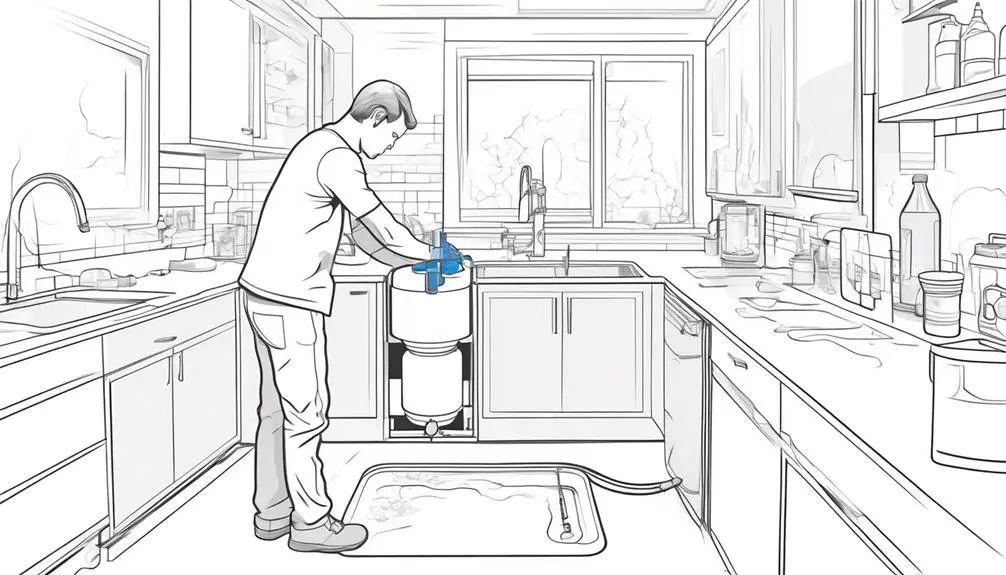Do you ever wonder what's really lurking in your drinking water?
Total Dissolved Solids (TDS) might hold the key to uncovering the mysteries within.
From salts to organic matter, these elements can shape the very essence of what flows from your tap.
But what does it all mean for you and your daily hydration routine?
Stay tuned to find out how deciphering TDS levels could make all the difference in your water-drinking experience.
Key Takeaways
- TDS levels in water impact taste, water hardness, and suitability for consumption.
- Optimal TDS for drinking water falls between 50-150 PPM, with levels above 1000 PPM considered unsafe.
- Monitoring TDS levels is essential for ensuring clean and safe water for everyday use.
- Treatment methods like Reverse Osmosis can effectively reduce high TDS levels to improve water quality.
Understanding Total Dissolved Solids (TDS)
If you've ever wondered what Total Dissolved Solids (TDS) really means in your drinking water, here's the simplified breakdown for you. TDS refers to the total amount of inorganic salts and a small portion of organic matter present in water. These dissolved solids can impact the taste, water hardness, and overall suitability of water for consumption. When TDS levels are high, water can taste salty, metallic, or bitter, and it may even cause scale formation due to minerals like calcium and magnesium.
To ensure good water quality and health, it's essential to monitor TDS levels. The optimal TDS level for drinking water typically falls between 50-150 parts per million (PPM). Levels above 1000 PPM are considered unsafe for consumption. To reduce TDS in your water, various filtration methods like Reverse Osmosis (RO), distillation, deionization, or boiling can be employed. Understanding and managing TDS levels is crucial for maintaining safe and healthy drinking water.
Importance of Measuring TDS Levels
Measuring TDS levels in your drinking water is key to understanding its quality and safety for consumption. By knowing the TDS levels, you can determine if there are any harmful substances present and assess any potential health risks.
Keeping an eye on TDS levels is crucial for ensuring that your water is clean, safe, and suitable for everyday use.
TDS Level Significance
Determining the significance of TDS levels in your drinking water is crucial for ensuring its suitability for consumption. Here's why measuring TDS levels is important:
- Water Quality: TDS levels indicate the total concentration of dissolved solids, affecting taste and overall quality.
- Health Concerns: While high TDS levels mightn't be directly harmful, they can impact water quality, taste, and appliance longevity.
- Regulations: Drinking water regulations recommend maintaining TDS levels between 50-150 PPM for safe consumption.
- Treatment Options: Methods like Reverse Osmosis (RO), distillation, or deionization can effectively reduce high TDS levels in water.
Understanding and monitoring TDS levels can help you ensure that your drinking water is safe and of good quality.
Health Implications
To comprehend the impact of TDS levels on your health, understanding their significance in your drinking water is essential. High levels of dissolved organic and inorganic substances in TDS can be a health concern. Elevated TDS levels mightn't pose a direct health hazard, but they can affect water quality.
Water with high TDS, containing substances like potassium, chloride, and sodium, could taste salty, metallic, or bitter, making it unsuitable for consumption. It's crucial to reduce TDS in water to ensure its safety. The Environmental Protection Agency recommends keeping TDS levels between 50-150 PPM for drinking water.
Regular testing and using appropriate water filtration methods, such as reverse osmosis or distillation, can help maintain a safe and healthy water supply.
Health Implications of High TDS
High TDS levels in drinking water can affect the taste and overall quality of your water, potentially impacting its suitability for consumption. Here are some key health implications of high TDS:
- Taste Alteration: High TDS levels can make your water taste salty, metallic, or bitter, reducing its palatability.
- Appliance Damage: Elevated TDS levels can lead to scale formation, affecting the efficiency of appliances like kettles, coffee makers, and irons.
- Plumbing Issues: High TDS levels can cause scale buildup in pipes, leading to clogs and reduced water flow over time.
- Calcium and Magnesium Salts: The types of salts present in high TDS water, like calcium and magnesium, can impact the overall quality of the water without posing a direct health hazard.
To address high TDS levels, consider using a TDS meter to monitor water quality, opting for reverse osmosis (RO) systems, or choosing water with a lower TDS level for consumption.
Effects of TDS on Plants
Elevated Total Dissolved Solids (TDS) levels in water can significantly impact the health and growth of plants. High TDS in water, often found in hard water or mineral water, can affect plants by altering soil structure and hindering nutrient absorption. To help you understand this better, here's a breakdown of how TDS levels can influence plant life:
| Effects of TDS on Plants | |
|---|---|
| Impact on Nutrient Uptake | High TDS levels can disrupt the balance of nutrients available to plants, affecting their growth and development. |
| Root Health | Excessive TDS in water may lead to poor root health in plants, making them more susceptible to diseases and reducing overall vitality. |
| Soil Structure | Elevated levels of TDS can negatively impact soil structure, making it harder for plants to establish strong root systems and access organic matter. |
| Overall Growth | Monitoring and controlling TDS in water, through filtration systems like RO systems, is crucial to ensure optimal conditions for plant growth. |
Understanding the effects of TDS on plants can help you make sure your plants thrive in the best possible environment.
Methods to Reduce TDS in Water

Looking to reduce TDS in your water?
Filtration systems like Reverse Osmosis technology are effective methods for lowering TDS levels.
These systems work by pushing water through a membrane to remove particles, providing you with cleaner and safer drinking water.
Filtration Systems
Curious about how to effectively reduce Total Dissolved Solids (TDS) in your drinking water? When looking to lower your TDS levels, choosing the right filtration system is crucial. Here are some methods to help you achieve this:
- Reverse Osmosis (RO): Pushes water through a membrane to filter out particles and reduce TDS levels effectively.
- Distillation: Boils water to separate dissolved salts, another method to lower TDS in water.
- Deionization (DI): Uses electrodes to separate ions from water, aiding in TDS reduction.
- Carbon Filters: Great for removing organic compounds and improving taste, but may not reduce TDS levels as effectively as RO, distillation, or deionization methods.
Consider these options to ensure your drinking water meets the desired TDS level.
Reverse Osmosis Technology
To effectively reduce Total Dissolved Solids (TDS) in your drinking water, consider utilizing Reverse Osmosis (RO) technology. RO systems work by pushing water through a semipermeable membrane to filter out impurities, reducing the concentration of dissolved substances and heavy metals. A total dissolved solids test measures the number of dissolved ions in water, helping determine the general quality. Normal TDS level ranges are typically measured in milligrams per liter. Here's a breakdown of different methods for reducing TDS:
| Method | Description | Effectiveness |
|---|---|---|
| Reverse Osmosis System | Uses a membrane to filter particles in water | High |
| Distillation | Boils water to separate salts and reduce TDS | High |
| Deionization (DI) | Separates ions from water using electrodes | Moderate |
Acceptable TDS Levels in Drinking Water
Understanding the ideal Total Dissolved Solids (TDS) levels in your drinking water is crucial for maintaining your health and well-being. Here are some key points to consider regarding acceptable TDS levels in drinking water:
- The acceptable TDS level in drinking water typically falls between 50-150 parts per million (PPM).
- TDS levels exceeding 1000 PPM are considered unsafe for consumption, indicating a high concentration of dissolved solids in the water.
- PureIt's Bisleri water maintains a TDS level of 150 PPM, within the safe range for drinking water.
- Monitoring the level of TDS in your water supply is essential to ensure that it meets the necessary standards to make water safe for consumption.
Factors Influencing TDS in Water

Factors influencing the Total Dissolved Solids (TDS) content in water are vital to understand for ensuring water quality. TDS levels are affected by various factors such as natural sources, human activities, and the type of piping used to distribute water.
Natural sources like rocks and soil can introduce inorganic salts into the water, while human activities such as sewage and industrial wastewater can add organic compounds to the mix. Both inorganic salts and organic compounds are commonly found in TDS.
The amount of organic and inorganic solids present in water contributes significantly to the overall TDS levels. Understanding these factors is crucial for determining the quality of water and the necessary treatment methods.
To maintain safe TDS levels, considering natural treatments like filtration or opting for water sources with lower dissolved solids can be effective in ensuring clean and safe drinking water.
Frequently Asked Questions
What Is a Good TDS Reading for Drinking Water?
For drinking water, a good TDS reading falls between 50-150 PPM. Levels above 1000 PPM become unsafe. Remember, it's about safety and taste. Check your water and stay within the safe zone for a refreshing drink.
How Do I Read My TDS Water Tester?
To read your TDS water tester, turn it on and immerse the probe in water. Wait for the reading to stabilize on the screen. The number displayed indicates the TDS level in your water, helping you assess its quality.
What Is the TDS Level for Drinking Water?
For drinking water, the TDS level should ideally be between 50-150 PPM. This range ensures water quality without compromising taste or health. Remember, maintaining the right TDS balance is key for a refreshing and safe drinking experience.
What Is Too Much TDS in Drinking Water?
Having too much TDS in your drinking water, above 1000 PPM, can be harmful. It affects taste, smell, and can lead to scale buildup. Make sure your levels stay between 50-150 PPM for safe consumption.
Conclusion
So, now that you've learned about TDS levels in your drinking water, remember: keeping those levels in check is like giving your water a spa day.
Just like how you'd take care of your skin, taking care of your water ensures it stays fresh and clean for you to enjoy.
Keep an eye on those TDS levels to ensure your water is as refreshing as a cool breeze on a hot day!
